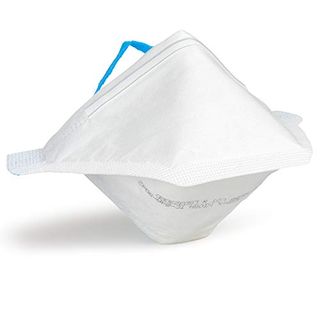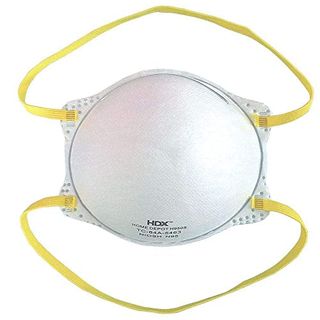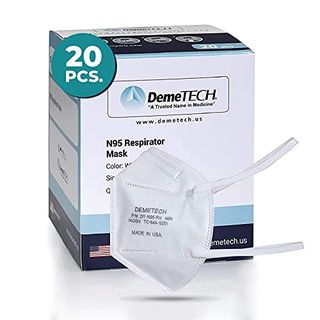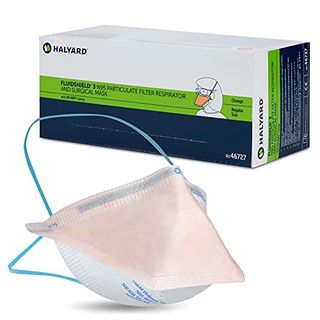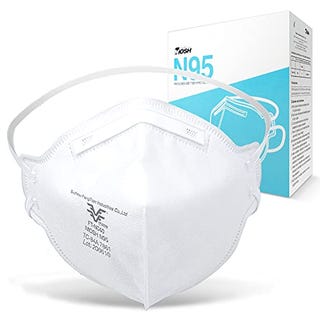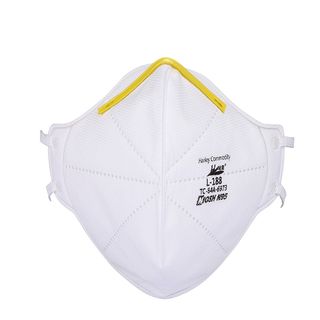- Meeting new federal mask recommendations, the best N95 masks are certified by health regulator NIOSH, and can be purchased online now.
- Good Housekeeping Institute experts are sharing tips for shopping for the best N95 masks and other respirators on the market.
- Plus, we’re sharing 6 tips for identifying fake, counterfeit N95 face masks that won’t effectively protect you from COVID-19 spread.
- Shop the best N95 masks below.
Masks have been part of our routine for over two years now, but many Americans may be confused about wearing respirators like the N95 after the Centers for Disease Control and Prevention (CDC) recently updated its guidance to suggest that N95s are most effective.
The N95 mask, typically worn by health care workers, is considered a gold standard for COVID-19 protection because it offers top-notch filtration. “In terms of features, the CDC says the N95 is ideal because they seal more tightly around the face and they filter up to 95% of particles in the air,” explains Lexie Sachs, Textiles Director within the Good Housekeeping Institute and a member of ASTM International’s committee for PPE . “The secure fit is especially important because other masks can have an air leak around the edges.”
Many people are still wearing cloth and surgical masks, though. The reason likely stems from the early days of the pandemic when the CDC suggested that the public forgo the N95 over concerns that shortages of the masks would prevent health care workers from accessing them. Now, however, shortages no longer exist — and the agency suggests individuals choose a disposable N95 in some situations.
Finding an N95 mask can be difficult, though, as shoppers eagerly snap up supplies in retail locations as well as online — and because they’re made differently than cloth masks, it can be equally tough to know which is best to buy. Sachs says that there are classifications that shoppers can keep an eye out for when shopping for face coverings, set by ASTM International — and for N95s specifically, the CDC’s National Institute of Occupational Safety and Health (otherwise called NIOSH) has been regulating production of N95 respirators over the pandemic.
Sachs stresses that best way to know if a respirator is effective and well-designed is if they carry the NIOSH certification. They should work to fit tightly across your nose, mouth and chin, as filtration depends on a tight seal. Below, we’re sharing what you should know about the best N95s, how they differ from other masks, and what to look for when shopping for face coverings.
The fiber scientists in the Good Housekeeping Institute Textiles Lab have been reviewing face masks since March 2020, starting with tutorials for DIY face coverings for both adults and kids before masks hit the mainstream market. We’ve worked with doctors and PPE (personal protective equipment) experts for face mask guidance and we also sit on the ASTM committee that developed the industry standard for testing face coverings.
What is an N95 respirator?
An N95 respirator is a “respiratory proactive device” that’s designed to fit tightly on your face and form a seal around the nose and mouth to filter out airborne particles. N95s often feature a “cup, flat fold or duckbill shape,” with two straps that secure around the head and a wire-nose bridge that forms to your face, according to the CDC. The respirators are made of a web of polypropylene fibers and some feature a valve to make breathing easier. Because N95 respirators form a tight seal, the CDC notes that they can sometimes be harder to breathe through.
The respirators have been worn in health care and industrial settings long before the pandemic, and they’re regulated by the CDC’s National Institute for Occupational Safety and Health (NIOSH). N95s are similar to KN95 masks in that they’re both respirators designed to filter out 95% of particles. However, only the N95 is approved for U.S.-based medical settings, while KN95 masks follow standards established in China. (Another similar option, the KF94, follows South Korean standards.) N95s haven’t always been easy to find, however. “The CDC acknowledges that the most widely-available respirator that meets international standards is the KN95,” Sachs says.
What does an N95 respirator protect you from during the COVID-19 pandemic?
N95 respirators are more effective than cloth and surgical masks because they filter out 95% of large and small particles, including bacteria and viruses, according to Cleveland Clinic. “They protect someone from inhaling particles of SARS-COV-2, the virus that causes COVID-19,” Sachs says. “If they fit properly, all airflow should go through the filters rather than leaking around the sides.”
In a study published in the journal Proceedings of the National Academy of Sciences in December, researchers found that COVID-19 transmission could be reduced by a factor of 75 when both an infected person and a person nearby are wearing an N95-type of mask compared to a surgical mask. Wearing an N95 was also found to provide more protection against COVID-19 and reduce health workers’ risk of getting infected, according to a 2021 study published in the Journal of Trauma and Acute Care Surgery.
This content is imported from Instagram. You may be able to find the same content in another format, or you may be able to find more information, at their web site.
However, the CDC suggests that you not wear an N95 if you have certain kinds of facial hair, if it’s hard for you to breathe while wearing one or if the mask gets dirty or wet. And, avoid wearing an N95 with another mask or respirator. People with chronic respiratory, heart or other medical conditions should ask their health care provider before wearing an N95.
Meant for single-use, N95s can’t be washed. But it’s often acceptable to re-wear them, as long as the mask isn’t soiled. If you’re wearing the mask for long periods of time, it’s a good idea to throw it away at the end of the day. Also, discard the respirator once it no longer fits snugly over your mouth or nose or if the elastic in the head straps stretches out.
How can I tell if N95s are counterfeit or fraudulent?
Millions of counterfeit N95 respirators falsely claiming to be NIOSH-approved are flooding the market lately. So, how do you know if a respirator is fraudulent? Here are some things to look for:
- They lack NIOSH approval markings. NIOSH-approved respirators contain an approval label with a number that starts with TC and is followed by seven digits. You can verify the approval number on the NIOSH Certified Equipment List to make sure it’s legit.
- They lack all markings. Along with a TC number, real N95s typically include a brand name, model number, lot number and NIOSH name or logo. This is what the markings should look like.
- NIOSH is misspelled. Fraudulent masks may be missing NIOSH marks altogether or the acronym isn’t spelled correctly.
- The respirators contain ear loops. Legitimate N95s feature head straps, not ear loops.
- The masks feature decorative elements. Real N95s do not come in decorative fabrics or feature flourishes like sequins.
- The manufacturer claims they’re approved for children. NIOSH hasn’t approved any respirators for children. “Some kid-sized N95s claim to be NIOSH-approved, but those are counterfeit,” Sachs says.
Look for a trusted brand name, too, Sachs suggests, such as 3M, Honeywell or Kimberly-Clark. “If you’re shopping on Amazon you may see international retailers selling N95s that claim to be NIOSH-approved, but those may be counterfeit,” she adds. To verify that an N95 is legitimate, check the CDC’s list of NIOSH-approved N95 respirators by the manufacturer.
What to look for when shopping for N95 respirators:
Before purchasing an N95 respirator, double-check a few things about the product.
- That it’s NIOSH-approved (verify it on the CDC’s list)
- That it features appropriate markings, like NIOSH approval, TC number, brand and model number (compare it to this CDC graphic)
- That it doesn’t show any other signs of counterfeit that we listed above
- That it’s manufactured by a reputable brand, such as 3M or Honeywell
While N95s do offer the best protection against COVID-19, they can be pricey (and costs are going up) and some people may find them uncomfortable to wear. “N95s are harder to breathe in, they’re more expensive, and they’re intended for single-use,” Sachs says. “So they’re not for everyone and may not be necessary for areas with lower risk of transmission. However, if you’re going to be in a higher-risk area for longer periods, they’re certainly going to keep you better protected.”
If you still prefer to wear a cloth mask, you can do so — as long as you choose to pair them with a surgical mask for best filtration results. Double masking is an easy alternative and may offer you similarly effective results.
This content is created and maintained by a third party, and imported onto this page to help users provide their email addresses. You may be able to find more information about this and similar content at piano.io



